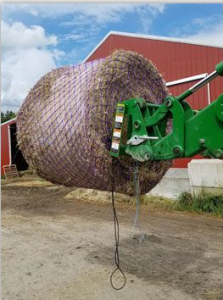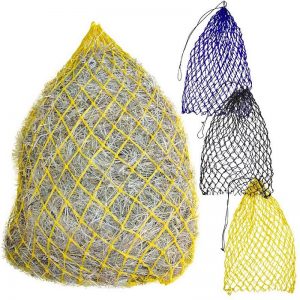| One option to accomplish this goal could to feed hay in a net, The University of Minnesota recently published a study to determine the effect of the hay net design on the amount and rate of hay consumed by a horse. They fed horses hay in three nets that had different size holes: large six-inch holes, medium one-and-¾-inch holes, and small one-inch holes. Results indicated horses eating hay from the six-inch nets did not eat any longer than horses fed without a hay net. However, horses eating hay out of nets with medium and small openings in the nets ate significantly slower and therefore ate longer than horses without nets. These results indicate that horses fed hay out of nets with openings of one to one 1 to one-and-¾-inch holes in diameter ate slower and ate smaller amounts longer than horses eating without a hay net or a net with large holes. So if you have a horse that is stalled most of the day, feeding in a hay net with small holes may be healthier for your horse.
Here are my ten tips to using Slow Feeder Haynets: 1. Help your horses get used to them by putting half their ration in the net to start with and give the rest loose so they are not super hungry while they’re working it out (which doesn’t take long!). 2. Keep it filled 24/7 – It will only take a few days for them to get used to ‘grazing’ their hay instead of gorging.
3. Fill the net by standing the bale up and pulling the net down over it while the strings are still attached – with a small net, you can put one on each end of the bale then cut the strings in the middle. Its easy then to wheel it out on a trolley. 4. Tie the draw string several times so there’s no room to fit a hoof through the loop. 5. By securing the net inside a box or a large truck tyre, you eliminate the pawing that can possibly wreck the net and it stops mud and manure ruining the hay. 6. Keep the net low to the ground so the feeding position is natural and the horse’s teeth are not worn abnormally (as when fed up high). 7. Use a clip to fasten the net in place – much faster than tying and un-tying it. 8. Spread the horse’s ration (approx. 1.5-2% of their bodyweight) between several nets that are placed in various parts of the paddock or on the track to encourage movement otherwise they stand around all day eating! 9. Have the water as far from the hay as possible (unless they are ill) to encourage movement.
10. Use your net to soak hay in – it keeps it together nicely and if you have a pulley above (wet hay is quite heavy), you can hang it up to drain. Please contact us if any questions, our sales team will always be happy to provide you with the most professional info. |


